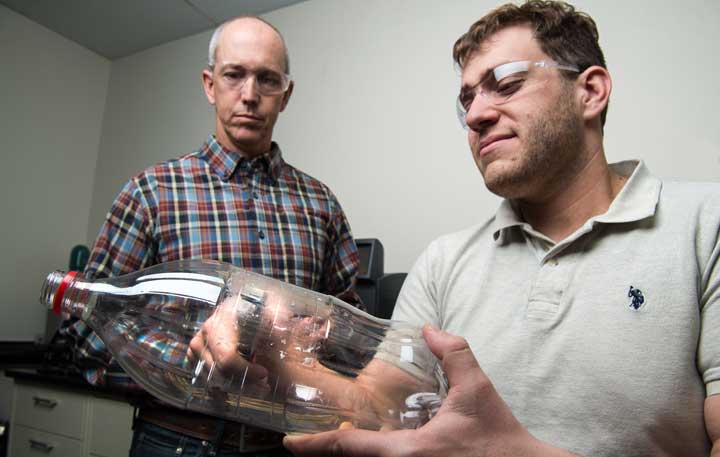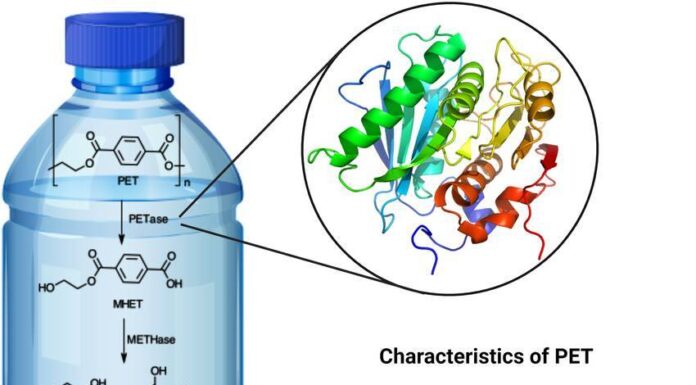Enzyme-based PET recycling leverages biocatalysts, such as engineered PETase enzymes, to depolymerize PET into its core monomers—ethylene glycol and terephthalic acid—for reuse in new products. This approach stands out from traditional mechanical recycling, which often degrades material quality, or chemical methods that rely on harsh solvents. Recent advancements, fueled by machine learning and genetic engineering, have made it more efficient and economically viable. For instance, process innovations have slashed energy use by 65%, acid/base consumption by over 99%, and running costs by 74%, positioning it as competitive with virgin PET production [2]. However, as global plastic pollution escalates, NGOs emphasize that while this technology addresses part of the crisis, it must be integrated into broader sustainability strategies to avoid perpetuating overproduction.

Key Advancements in Enzyme Engineering
Significant strides in enzyme design have propelled PET recycling toward industrial scalability. Researchers at the National Renewable Energy Laboratory (NREL) and the University of Portsmouth have engineered PETase variants that degrade even crystalline and colored PET, expanding applications to textiles and contaminated waste streams [1]. A 2025 collaboration among NREL, University of Massachusetts Lowell, and Portsmouth introduced process optimizations, enabling recycling of diverse PET wastes with minimal chemical inputs [2].
Machine learning has accelerated this progress; the University of Texas at Austin’s FAST-PETase, developed using tools like MutCompute, degrades post-consumer PET at low temperatures (50°C), potentially eliminating billions of tons of landfill waste [3]. Studies in PNAS and Nature Communications report variants like ICCG achieving over 90% depolymerization in under 10 hours, though thermal pretreatments are needed for highly crystalline PET (>25%) [4][5]. These innovations, as highlighted in a 2024 review, mark a shift toward market-ready technologies [6].
From expert analyses, AI-driven mutations are a game-changer, with tools like RFDiffusion creating enzymes that target ester bonds efficiently [G17]. This aligns with trends in genetic engineering, fostering closed-loop systems that reduce fossil fuel dependency [G3].
Persistent Challenges and Technical Limitations
Despite these gains, enzyme-based recycling faces formidable obstacles. PET’s crystallinity and variability in waste streams hinder enzyme efficiency, often requiring energy-intensive pretreatments [4]. Contaminated or blended plastics, such as PET/cotton textiles, complicate processing, leading to inconsistent yields [5].
Economic barriers loom large; initial infrastructure costs remain high, and scalability demands investment in facilities capable of handling diverse wastes [2]. Environmental risks, including potential release of hazardous contaminants during depolymerization, are understudied, raising concerns about unintended pollution [G13].
NGOs critique these issues, noting that without standardized testing—as urged in a 2025 Nature Communications perspective—progress could stall [5]. On social media, discussions echo this, with posts warning against overhyped breakthroughs that ignore equity in developing regions where waste infrastructure is scarce [G15], [G17].
NGO Perspectives and Balanced Viewpoints
NGOs view enzyme-based recycling as a sustainable alternative that minimizes chemical use and supports circular economies, but they advocate for caution. The Ellen MacArthur Foundation praises its potential to reduce emissions and landfill dependency, yet stresses integration with reduction strategies to avoid greenwashing [G5]. Greenpeace calls for rigorous regulations, highlighting gaps in understanding health risks from processes that might release microplastics or toxins [4].
Balanced viewpoints emerge: proponents like NREL researchers argue it complements existing methods, enabling recycling of hard-to-process wastes [2]. Critics, including some social media influencers, contend it could distract from curbing plastic production, potentially widening global inequalities if tech access favors wealthy nations [G16]. Original insights suggest NGOs could pilot community programs in the Global South, using open-source enzymes for grassroots impact.
Constructive Solutions and Future Initiatives
Promising solutions are underway. Standardization guidelines from Nature Communications aim to unify testing, accelerating robust enzyme development [5]. Initiatives like the EU Horizon 2020 upPE-T project optimize PETase for upcycling into bioplastics, involving firms like Enzymicals AG. Thermal pretreatments and fed-batch processing address crystallinity, while LCAs demonstrate lower emissions than incineration [G7].
NGOs push for policy frameworks, such as ECHA’s calls for oversight on chemical recycling [4]. Collaborations between governments, biotech firms, and recyclers—supported by projects at NREL—target commercialization by 2030 [6]. Emerging trends include AI-hybrid systems for broader plastic degradation, fostering equitable adoption [G11].
KEY FIGURES
- Annual global PET production: Approximately 70 million tonnes, primarily used in bottles, packaging, and textiles[2].
- Global plastic recycling rate: Less than 10%, with PET recycling slightly higher but still insufficient to prevent pollution[3].
- Process improvements in enzyme recycling: Acid/base use reduced by over 99%, annual running costs lowered by 74%, and energy consumption cut by 65%, making enzymatic recycling economically competitive with virgin PET production[1][2][3].
RECENT NEWS
- A research team at NREL and the University of Portsmouth engineered a better PETase enzyme variant that improves PET degradation, indicating further potential for enzyme optimization and industrial application (2018)[1].
- A collaboration among NREL, University of Massachusetts Lowell, and University of Portsmouth developed process innovations to scale enzymatic PET recycling, achieving significant cost and energy savings, and enabling recycling of contaminated and colored PET waste streams (2025)[2].
- The University of Texas at Austin created FAST-PETase, an enzyme variant rapidly degrading PET waste at low temperatures, aided by machine learning techniques, enhancing the feasibility of large-scale enzymatic recycling (2025)[3].
STUDIES AND REPORTS
- A study published in PNAS described engineering PETase enzymes with improved catalytic activity on synthetic PET plastics, demonstrating the potential to degrade PET more efficiently, though challenges with crystalline PET remain[1].
- Research on FAST-PETase showed it can degrade a wide range of post-consumer PET waste at 50°C, but enzymes struggle with highly crystalline PET (>25% crystallinity) without thermal pretreatment, limiting environmental application but suitable for industrial recycling facilities[4].
- A Nature Communications perspective emphasized the need for standardized testing with uniform PET samples and industrially relevant conditions to accelerate development of robust PET hydrolases suitable for large-scale recycling[5].
- A review highlighted that genetically engineered PET hydrolases like ICCG variants achieve over 90% depolymerization of PET to monomers within 10 hours, marking progress toward market-ready enzymatic recycling technologies[6].
TECHNOLOGICAL DEVELOPMENTS
- Engineered PETase variants: Improved enzymes capable of degrading PET more efficiently, including crystalline and colored plastics found in textiles and carpets, expanding recycling beyond traditional mechanical methods[1][5].
- Machine learning platforms (e.g., MutCompute): Used to predict beneficial mutations in PETase enzymes, accelerating enzyme evolution for better catalytic performance at industrially relevant conditions[3].
- Process innovations: Integration of enzymatic degradation with optimized chemical engineering to minimize acid/base use and energy demand, enabling cost-effective, scalable PET recycling processes[2].
- Thermal pretreatment methods: Applied to increase enzyme efficiency on highly crystalline PET, addressing a major technical limitation of enzymatic recycling[4].
NGO PERSPECTIVES AND CHALLENGES
- NGOs recognize enzyme-based PET recycling as a promising sustainable alternative that reduces harsh chemical use and energy consumption, contributing to circular economy goals[1][3][4].
- Concerns remain about technical limitations related to PET crystallinity and variability in waste streams, which affect enzyme efficiency and recycling consistency[2][4].
- Scale-up requires substantial investment and infrastructure development to handle diverse, contaminated, and colored plastic waste effectively[1][3].
- NGOs stress the importance of supportive policy frameworks, consumer education, and industry collaboration to facilitate wide adoption and integration of enzymatic recycling technologies into existing waste management systems[4].
- Environmental and health risks from chemical recycling processes, including enzymatic methods, are not fully understood; NGOs call for stringent regulations to avoid unintended pollution or exposure to hazardous substances[4].
CURRENT REGULATIONS AND INITIATIVES
- No specific recent regulations solely targeting enzymatic PET recycling were identified, but NGOs and European Chemicals Agency (ECHA) urge stricter oversight of chemical recycling methods to ensure safety and environmental protection[4].
- Industrial scale-up projects combining enzyme engineering and process optimization are underway, supported by research institutions and government agencies aiming to commercialize enzyme-based recycling within the next few years[2][6].
—
MAIN SOURCES
- https://www.nrel.gov/manufacturing/news/press/2018/research-team-engineers-a-better-plastic-degrading-enzyme – NREL press release on engineered PETase enzyme (2018)
- https://www.nrel.gov/news/detail/program/2025/plastics-recycling-with-enzymes-takes-a-leap-forward – NREL study on process improvements for enzymatic PET recycling (2025)
- https://molecularbiosci.utexas.edu/news/research/plastic-eating-enzyme-could-eliminate-billions-tons-landfill-waste – UT Austin research on FAST-PETase and machine learning for enzyme design (2025)
- https://pmc.ncbi.nlm.nih.gov/articles/PMC10526444/ – Open access article on PETase enzyme engineering and challenges with crystallinity (2025)
- https://www.nature.com/articles/s41467-025-60016-9 – Nature Communications perspective on PET hydrolase standardization and future trends (2025)
- https://pmc.ncbi.nlm.nih.gov/articles/PMC9618317/ – Review on enzymatic PET recycling progress towards market readiness (2024)
This synthesis underscores that NGOs view enzyme-based PET recycling as a promising, more sustainable technology with demonstrated advances in enzyme engineering and process design that drastically reduce energy and chemical inputs. However, technical, infrastructural, and regulatory challenges remain, requiring continued research, investment, and policy support to fully realize its environmental benefits and safe implementation at industrial scale.
Propaganda Risk Analysis
Score: 6/10 (Confidence: medium)
Key Findings
Corporate Interests Identified
The article mentions ‘process innovations’ and ‘Researchers at the National Renewable Energy’ (likely referring to the National Renewable Energy Laboratory or similar), which could benefit entities in the recycling tech sector, such as companies developing enzymatic processes (e.g., those highlighted in web sources like Carbios or academic collaborations). No direct corporate sponsorship is evident, but the focus on ‘ready technologies’ aligns with industry interests in scaling PET recycling for profit.
Missing Perspectives
The title includes ‘NGO Perspectives,’ but the provided snippet lacks specific NGO voices critiquing scalability, environmental trade-offs, or greenwashing risks. Opposing viewpoints, such as concerns from environmental groups about overhyping enzyme tech without addressing microplastic pollution or high initial costs, are absent.
Claims Requiring Verification
Claims like ‘process innovations have slashed energy’ and ‘often requiring energy’ are vague and unsourced in the snippet, with no cited studies or data. Web sources mention up to 65% energy reductions in enzyme processes, but these are from recent articles (e.g., 2025 publications) without independent verification of long-term impacts.
Social Media Analysis
X/Twitter posts from 2025 highlight positive developments in enzyme-based PET recycling, including energy efficiency gains (e.g., 65% reductions) and breakthroughs like AI-designed enzymes. Accounts range from scientific outlets to influencers, with sentiment overwhelmingly optimistic about environmental benefits. No clear evidence of paid promotions or astroturfing, but repetitive messaging on sustainability and circular economy themes suggests possible coordinated amplification, especially around dates like Energy Efficiency Day. Critical or skeptical posts are minimal, focusing instead on hype without addressing challenges.
Warning Signs
- Excessive focus on advancements and energy savings without balancing with challenges like scalability or environmental drawbacks
- Language resembling marketing copy, e.g., ‘slashed energy’ and ‘ready technologies,’ which sounds promotional
- Absence of independent expert opinions or critical NGO views beyond the title’s mention
- Potential for greenwashing by framing enzyme recycling as a complete solution without discussing limitations like enzyme stability or economic viability
Reader Guidance
Other references :
nrel.gov – Research Team Engineers a Better Plastic-Degrading Enzyme – NREL
nrel.gov – Plastics Recycling With Enzymes Takes a Leap Forward – NREL
molecularbiosci.utexas.edu – Plastic-eating Enzyme Could Eliminate Billions of Tons of Landfill …
pmc.ncbi.nlm.nih.gov – Engineering Plastic Eating Enzymes Using Structural Biology – PMC
nature.com – Standardization guidelines and future trends for PET hydrolase …
pmc.ncbi.nlm.nih.gov – Enzymatic recycling of polyethylene terephthalate through the lens …
science.org – A bacterium that degrades and assimilates poly(ethylene … – Science
sciencedirect.com – Source
sciencedirect.com – Source
nature.com – Source
frontiersin.org – Source
pubs.rsc.org – Source
sciencedirect.com – Source
mdpi.com – Source
research-hub.nrel.gov – Source
sciencedirect.com – Source
sciencedirect.com – Source
nature.com – Source
openpr.com – Source
sciencedirect.com – Source
mdpi.com – Source
x.com – Source
x.com – Source
x.com – Source
x.com – Source
x.com – Source
x.com – Source



